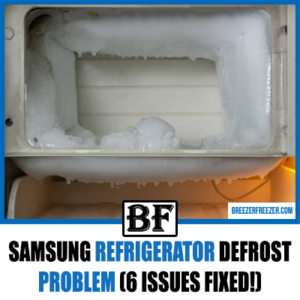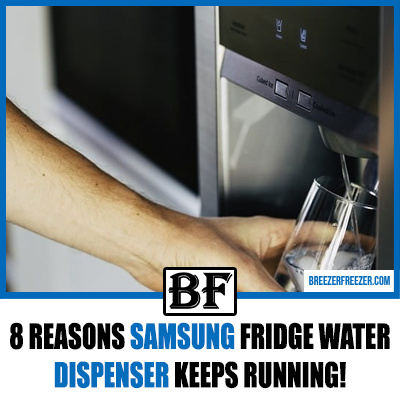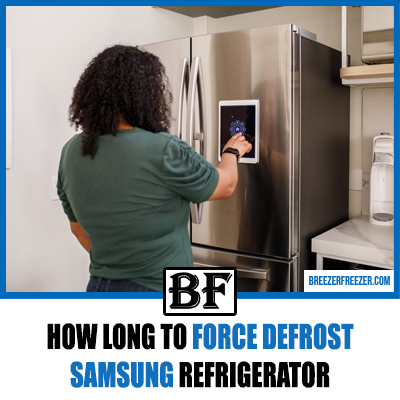Samsung Refrigerator Defrost Problem (6 Issues Fixed!)
When faced with a defrost problem in your Samsung refrigerator, it’s important to consider several factors. Frost buildup is not a random occurrence, indicating that something has likely malfunctioned. Understanding the potential causes is crucial in resolving the issue.

There are several common reasons why a Samsung refrigerator may fail to defrost. These include the presence of warm air entering through an open door, inadequate airflow, an open ice flap, a leak or blockage in the drain tube, component failures, or a refrigerant leak.
Various components can contribute to the malfunctioning of the defrosting mechanism. These components include the defrost timer, defrost heater assembly, defrost thermostat, defrost control board, defrost sensor fuse, compressor, and central control board.
In the following sections, we will explore how these issues can prevent your Samsung refrigerator from defrosting and provide solutions to rectify them.
But before we delve into the solutions, let’s first discuss how you can manually initiate the defrost mode in your Samsung refrigerator and what steps to take if it fails to defrost automatically. This approach may offer a potential fix for the problem at hand.
Quick Troubleshooting Guide
| Likely Cause | Quick Fix |
| Warm Air Leaking (in) through the Door | Force-defrost the refrigerator and correctly shut the door each time you open it |
| Improper Aeration | Space the food evenly, away from the freezer walls, and force-defrost the fridge |
| Open Ice Flap | Remove any obstructions that could be preventing the ice maker flap from closing correctly, and then force-defrost the refrigerator |
| Drain Tube Moisture Leak or Blockage | Have an expert inspect the drain tube for moisture leakage or blockage and fix it |
| Component Failure | Inspect the defrost timer, defrost heater assembly, defrost thermostat, defrost control board, defrost sensor fuse, compressor, and central control board for faults and replace them |
| Refrigerant Leak | Call a professional technician |
How to Activate Defrost Mode
Entering Defrost Mode
To begin addressing a defrost issue in your Samsung refrigerator, it’s important to understand the defrost mode. All Samsung refrigerators have a defrost mode that allows them to melt accumulated frost and ice. Under normal circumstances, Samsung refrigerators automatically defrost multiple times a day, with each defrost cycle lasting approximately 20 minutes.
However, if your refrigerator is not defrosting properly, you may need to manually initiate a defrost. Here’s how you can enter the defrost mode:
Step 1: Access Diagnostic Mode Press and hold either the Light + Freezer or PowerFreeze + Fridge buttons on the control panel for about 10 seconds. The refrigerator will emit a chime sound to indicate that it has entered diagnostic mode.
Step 2: Select Defrost Mode Once in diagnostic mode, you can choose your desired defrost mode. There are two options available:
- Refrigerator Defrost (RD): This mode only defrosts the fresh food section (refrigerator compartment). Select this mode if you want to specifically target ice buildup in the refrigerator compartment.
- Full Defrost (FD): Unlike the refrigerator defrost mode, the full defrost mode defrosts both the refrigerator and freezer compartments.
Step 3: Allow Defrost Cycle to Complete After selecting your preferred defrost mode, give the refrigerator 20 to 60 minutes to run the defrost cycle. The duration of the defrosting process depends on the amount of frost accumulation. Once the cycle is complete, the refrigerator will emit a beeping sound.
Other Methods to Forcefully Defrost a Samsung Refrigerator:
In addition to manually entering defrost mode, there are alternative methods to melt accumulated ice in your Samsung refrigerator:
- Use hot or warm water: Run hot or warm water through the refrigerator’s vents while the unit is unplugged. Alternatively, place trays of hot water inside the fridge and wait until the ice begins to melt, allowing you to remove the ice bucket.
- Utilize a fan: If available, use a portable fan outside the refrigerator to facilitate ice melting. Opening the refrigerator door during this process will help expedite defrosting.
- Leave the door open: Although leaving the door open can contribute to ice formation, it can also serve as a solution. Unplug the refrigerator for approximately a day and keep the door open to allow for natural defrosting.
- Try a hand steamer: Instead of using a hairdryer, which may generate excessive heat and potentially damage the fridge, consider using a hand steamer. Empty the refrigerator before using the steamer to melt the ice.
Common Causes of Defrost Problems in Samsung Refrigerators
If your Samsung refrigerator fails to defrost properly, consider these potential causes:
Warm air leakage through the door
Improper sealing or leaving the door open for extended periods can introduce warm air into the refrigerator, leading to accelerated ice accumulation. Ensure the door is firmly closed and replace the door seal if necessary.
Inadequate airflow
Proper ventilation, especially in the freezer compartment, is crucial for the defrosting process. Overloading the refrigerator with food, particularly when containers rest against the freezer walls, can impede proper airflow. Reduce the food load and ensure containers do not obstruct air vents.
Obstructed ice maker flap
Debris or dirt accumulation on the ice maker flap can prevent it from closing properly, hindering the defrost process. Inspect the flap and remove any obstructions to facilitate proper defrosting.
Moisture leakage or blockage in the drain tube
Leaking moisture or significant dust buildup in the drain tube can interfere with defrosting. Contact a professional if the drain tube requires inspection or if it is blocked. Attempt a forced defrost in the meantime.
Component failure
Various components, such as the defrost timer, defrost heater assembly, defrost thermostat, defrost control board, defrost sensor fuse, compressor, or main control board, can cause defrosting issues when they malfunction. Consult a refrigerator expert to diagnose and replace any faulty components.
Refrigerant leak
A low refrigerant level can result in a malfunctioning compressor, leading to inadequate defrosting. Addressing refrigerant leaks requires professional assistance.
Defrost Issues in Samsung French Door Refrigerators:
Similar to other refrigerator types, Samsung French door refrigerators may experience defrosting problems due to the following factors:
- Warm air leakage through the door
- Food overloading obstructing air vents
- Obstructions in the ice maker flap
- Leaky or obstructed drain tube
- Refrigerant leakage
- Malfunctioning defrost system components, compressor, or main control board
Dealing with Samsung Refrigerator Defrost Sensor Error Code 5E
The error code 5E is commonly associated with defrost system component malfunctions, system glitches, or control unit failures. To clear the 5E error code, you can try the following steps:
- Reset the refrigerator by unplugging it for 10 to 15 minutes.
- Press and hold the PowerFreeze + PowerCool buttons simultaneously for 10 seconds.
Remember, if you encounter persistent defrost issues or require assistance with specific components, it is advisable to consult a professional refrigerator technician.
People Also Ask
How Do I Fix the Defrost On My Samsung Refrigerator?
To fix the defrost issue in your Samsung refrigerator, you can manually defrost it by pressing the PowerFreeze + fridge buttons or lights + freezer buttons for 10 seconds. If manual defrosting doesn’t work, check the defrost components for any faults.
How Do I Force-Defrost My Samsung Fridge?
To force-defrost your Samsung fridge, press the lights + freezer buttons or power freeze + fridge buttons on the control panel for approximately 10 seconds. If this method doesn’t work, you can try using a hand steamer, fan, or warm water to melt the accumulated frost.
How Long Does a Samsung Forced Defrost Take?
The automatic defrost cycle in a Samsung refrigerator typically takes around 20-60 minutes, depending on the amount of frost present. However, a manual defrost (forceful defrost) may take up to 24-36 hours.
In conclusion
You now have an understanding of the potential causes of defrost problems in your Samsung refrigerator. These issues can include warm air leakage, poor airflow, obstruction of the ice flap, a leaky or blocked drain tube, component failures, or low refrigerant levels. If your refrigerator fails to defrost automatically, remember to manually defrost it to address the issue.


![Frigidaire Freezer Making Loud Buzzing Noise? [9 Reasons Fixed!]](https://breezerfreezer.com/wp-content/uploads/2023/10/Frigidaire-Freezer-Making-Loud-Buzzing-Noise.png)


